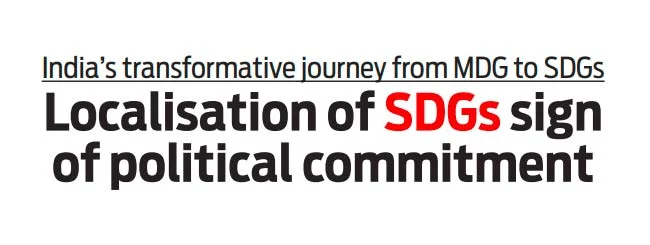Col DPK Pillay
THE 2030 Agenda for Sustainable Development, adopted by the United Nations General Assembly, outlines 17 Sustainable Development Goals (SDGs) supported by 169 targets and 213 indicators. This comprehensive framework addresses global challenges across five key pillars: People, Planet, Prosperity, Peace, and Partnership. The SDGs build upon the Millennium Development Goals (MDGs), aiming to eradicate poverty and hunger while ensuring sustainable prosperity for all individuals within a balanced global ecosystem.
Profound transformation
India’s transition from the Millennium Development Goals (MDGs) to the Sustainable Development Goals (SDGs) represents a profound transformation in its approach to development. This shift not only marked a change in global development priorities but also coincided with significant political changes within India, reflecting a broader evolution in the country’s approach to development. The transition highlights India’s active engagement in shaping global development agendas and driving achievements that have become benchmarks for the international community.
Under the MDGs, India made commendable progress, particularly in public health, with significant strides in combating diseases such as HIV/ AIDS, tuberculosis, malaria, and polio. However, the progress achieved did not fully realise the potential impact of these goals. For example, while improvements were made in education and health, certain targets, such as universal education and reducing child mortality, fell short of their potential.
One critical lesson from the MDGs was the importance of strengthening local governance structures. The MDGs revealed that robust local governance is essential for driving grassroots progress. In response, India has since prioritised empowering local bodies and enhancing their capacities to foster community-led initiatives and inclusive growth efforts.
Regional disparities
Another lesson was the need to address regional disparities, as the MDGs exposed significant gaps between different states and regions. To counter this, India has implemented targeted resources and interventions in lagging areas, promoting more equitable and comprehensive growth. The siloed approach of the MDGs also emphasised the necessity for an integrated perspective.
India has adopted a cross-cutting planning approach under the SDGs, addressing interconnected issues like poverty, healthcare, and environmental protection in a unified manner. This shift aims to develop comprehensive solutions that reflect the interdependencies of various development challenges.
Evolving Strategies
Building on the lessons from the MDGs, India has refined its strategies to better address past shortcomings and enhance its approach to sustainable development. Embracing cross-cutting planning has become a cornerstone of India’s strategy, recognising the interconnected nature of development challenges and focusing on integrated solutions. This approach ensures that efforts in one sector complement and reinforce those in others. India has also implemented targeted strategies to prioritise development in regions requiring special attention.
This targeted approach aims to bridge developmental gaps and promote more equitable growth across the country. Data-driven decision-making has become a central feature of India’s strategy, with robust mechanisms in place to track progress and inform resource allocation. This focus on data ensures that interventions are based on evidence and can be adjusted as needed to achieve the desired impact. Strategic partnerships have been actively cultivated to leverage collective expertise and resources.
Collaborative approach
India collaborates with various stakeholders, including governments, private entities, and civil society organisations, to drive impactful SDG initiatives. Additionally, localisation of SDG frameworks has been a key strategy, with efforts tailored to meet the unique needs of specific regions and communities. This approach ensures that development benefits reach the most vulnerable populations and addresses local challenges effectively.
















